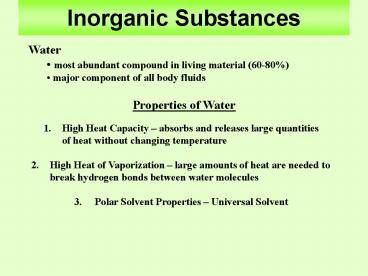Inorganic Substances - PowerPoint PPT Presentation
1 / 14
Title:
Inorganic Substances
Description:
Inorganic Substances Water ... waste product released during metabolic reactions must be removed from the body Inorganic salts ionic compounds that don t contain H+ ... – PowerPoint PPT presentation
Number of Views:816
Avg rating:3.0/5.0
Title: Inorganic Substances
1
Inorganic Substances
- Water
- most abundant compound in living material
(60-80) - major component of all body fluids
Properties of Water
- High Heat Capacity absorbs and releases large
quantities - of heat without changing temperature
- High Heat of Vaporization large amounts of heat
are needed to - break hydrogen bonds between water molecules
3. Polar Solvent Properties Universal
Solvent
2
Inorganic Substances
Properties of Water
4. Reactivity hydrolysis dehydration
synthesis
5. Cushioning
- Oxygen (O2)
- used by organelles to release energy from
nutrients - necessary for survival
3
Inorganic Substances
- Carbon dioxide (CO2)
- waste product released during metabolic
reactions - must be removed from the body
- Inorganic salts
- ionic compounds that dont contain H or OH-
- abundant in body fluids
- sources of necessary ions (Na, Cl-, K, Ca2,
etc.) - play important roles in metabolic processes
2-21
4
Organic SubstancesCarbohydrates
- provide energy to cells
- supply materials to build cell structures
- water-soluble
- contain C, H, and O
- ratio of H to O close to 21 (C6H12O6)
- monosaccharides glucose, fructose
- disaccharides sucrose, lactose
- polysaccharides glycogen, cellulose, starch
2-22
5
Organic SubstancesCarbohydrates
2-23
6
Organic SubstancesLipids
- soluble in organic solvents
- Fats (triglycerides)
- used primarily for energy
- contain C, H, and O but less O than
carbohydrates (C57H110O6) - building blocks are 1 glycerol and 3 fatty acids
per molecule - saturated and unsaturated
2-24
7
Types of Fatty Acids
Saturated Fatty Acids all carbon atoms form
single bonds with hydrogen fully
loaded/saturated with hydrogen straight fatty
acid chains Saturated Fats bad fat, solid at
room temperature, contain only saturated fatty
acids.
Unsaturated Fatty Acids contain one or more
double bond between carbon atoms Monounsaturate
d one double bond Polyunsaturated two or
more double bonds Unsaturated Fats healthier,
especially mono liquid at room temperature
contain only unsaturated fatty acids fatty acid
chains are kinked
8
Organic SubstancesLipids
- Phospholipids
- building blocks are 1 glycerol, 2 fatty acids,
and 1 phosphate per molecule - hydrophilic(polar) and hydrophobic (nonpolar)
- major component of cell membranes
2-25
9
Organic Substances Lipids
- Steroids
- four connected rings of carbon
- cholesterol from animal products
- component of cell membrane
- used to synthesize hormones
2-26
10
Organic SubstancesProteins
- structural material
- energy source
- hormones
- receptors
- enzymes
- antibodies
- building blocks are amino acids
- amino acids held together with peptide bonds
2-27
11
Organic Substances Proteins
Four Levels of Structure
2-28
12
Conformation shape that determines the function
of a protein determined by amino acid
sequence Denature protein conformation falls
apart --caused by high temperature, pH changes,
and chemicals
13
Organic SubstancesNucleic Acids
- constitute genes
- play role in protein synthesis
- building blocks are nucleotides
- DNA (deoxyribonucleic acid) double
polynucleotide - RNA (ribonucleic acid) single polynucleotide
2-29
14
Organic SubstancesNucleic Acids
2-30































